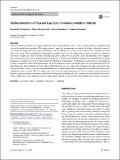Files in this item
Underestimation of Pearson's product moment correlation statistic
Item metadata
| dc.contributor.author | Humphreys, Rosalind K. | |
| dc.contributor.author | Puth, Marie-Therese | |
| dc.contributor.author | Neuhäuser, Markus | |
| dc.contributor.author | Ruxton, Graeme Douglas | |
| dc.date.accessioned | 2018-08-06T09:30:08Z | |
| dc.date.available | 2018-08-06T09:30:08Z | |
| dc.date.issued | 2019-01 | |
| dc.identifier | 255043566 | |
| dc.identifier | fc1de5a2-b9ba-4293-a22c-9041a15814ca | |
| dc.identifier | 85051081183 | |
| dc.identifier | 000455167600001 | |
| dc.identifier.citation | Humphreys , R K , Puth , M-T , Neuhäuser , M & Ruxton , G D 2019 , ' Underestimation of Pearson's product moment correlation statistic ' , Oecologia , vol. 189 , no. 1 , pp. 1-7 . https://doi.org/10.1007/s00442-018-4233-0 | en |
| dc.identifier.issn | 0029-8549 | |
| dc.identifier.other | ORCID: /0000-0001-7266-7523/work/48774960 | |
| dc.identifier.other | ORCID: /0000-0001-8943-6609/work/60427517 | |
| dc.identifier.uri | https://hdl.handle.net/10023/15770 | |
| dc.description.abstract | Pearson’s product moment correlation coefficient (more commonly Pearson’s r) tends to underestimate correlations that exist in the underlying population. This phenomenon is generally unappreciated in studies of ecology, although a range of corrections are suggested in the statistical literature. The use of Pearson’s r as the classical measure for correlation is widespread in ecology, where manipulative experiments are impractical across the large spatial scales concerned; it is therefore vital that ecologists are able to use this correlation measure as effectively as possible. Here, our literature review suggests that corrections for the issue of underestimation in Pearson’s r should not be adopted if either the data deviate from bivariate normality or sample size is greater than around 30. Through our simulations, we then aim to offer advice to researchers in ecology on situations where both distributions can be described as normal, but sample sizes are lower than around 30. We found that none of the methods currently offered in the literature to correct the underestimation bias offer consistently reliable performance, and so we do not recommend that they be implemented when making inferences about the behaviour of a population from a sample. We also suggest that, when considering the importance of the bias towards underestimation in Pearson’s product moment correlation coefficient for biological conclusions, the likely extent of the bias should be discussed. Unless sample size is very small, the issue of sample bias is unlikely to call for substantial modification of study conclusions. | |
| dc.format.extent | 7 | |
| dc.format.extent | 963486 | |
| dc.language.iso | eng | |
| dc.relation.ispartof | Oecologia | en |
| dc.subject | Association | en |
| dc.subject | Bias | en |
| dc.subject | Correlation | en |
| dc.subject | Pearson’s r | en |
| dc.subject | Sampling | en |
| dc.subject | HA Statistics | en |
| dc.subject | QH301 Biology | en |
| dc.subject | T-NDAS | en |
| dc.subject.lcc | HA | en |
| dc.subject.lcc | QH301 | en |
| dc.title | Underestimation of Pearson's product moment correlation statistic | en |
| dc.type | Journal article | en |
| dc.contributor.institution | University of St Andrews. School of Biology | en |
| dc.contributor.institution | University of St Andrews. Centre for Biological Diversity | en |
| dc.identifier.doi | 10.1007/s00442-018-4233-0 | |
| dc.description.status | Peer reviewed | en |
| dc.identifier.url | https://link.springer.com/article/10.1007/s00442-018-4233-0#SupplementaryMaterial | en |
This item appears in the following Collection(s)
Items in the St Andrews Research Repository are protected by copyright, with all rights reserved, unless otherwise indicated.

